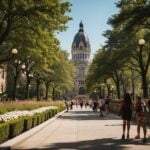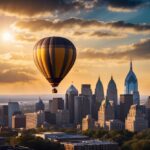Philadelphia’s Benjamin Franklin Parkway is an unmistakable grand boulevard and cultural centerpiece of the city. Its mile-long expanse stretches from the heart of downtown at City Hall all the way to the famous Philadelphia Museum of Art at its northwestern end. This iconic urban thoroughfare is a masterpiece of urban design and planning from the City Beautiful movement era.
The Parkway’s stately architecture, landscaped gardens, fountains, and public art instantly captivate visitors. Several of Philadelphia’s most important cultural institutions line the boulevard, including the dazzling Rodin Museum, the interactive Franklin Institute science museum, and the esteemed Barnes Foundation gallery. At the Parkway’s entrance, the majestic Cathedral Basilica of Saints Peter and Paul presides over the scenery.
Just off the Parkway, Fairmount Park offers a natural oasis with miles of walking trails, picturesque river views, and popular attractions like the Philadelphia Zoo and Please Touch Museum for kids. The nearby Schuylkill River Banks boardwalk and trail provides recreation and waterfront dining along the Parkway’s western side.
The Benjamin Franklin Parkway resides within the Fairmount neighborhood, part of Philadelphia’s broader Center City district. This upscale area is known for residential town homes, scenic parks, and lively restaurant and nightlife scenes along streets like Fairmount Avenue and Callowhill Street bordering the Parkway.
From its iconic annual events like the Thanksgiving Day Parade and outdoor movie nights to its daily stream of joggers and cyclists, the Benjamin Franklin Parkway reflects the beating heart of Philadelphia’s vibrant culture. Its architectural grandeur and public spaces have transformed over decades into an unmatched amenity for residents and a must-see destination for visitors.
Table of Contents
History and Conception
The Benjamin Franklin Parkway has its origins in the late 19th century City Beautiful movement that aimed to improve urban life through civic engagement and introducing more beauty to cities. The movement took hold in Philadelphia, with the Parkway being the city’s most ambitious project inspired by these principles of urban renewal and classical design.
Planning for the Parkway began in 1892 when the project was proposed by architect Jacques Gréber. He envisioned a tree-lined boulevard that would become a vital artery connecting the northwestern neighborhoods to City Hall and downtown. Gréber’s original design called for the Parkway to stretch from City Hall to Fairmount Park.
Construction on the Parkway started in 1917, with the first portion opening in 1925. It took over 60 years for the full mile-long boulevard and all its grand buildings to be completed according to the original architectural vision. The design drew heavy inspiration from the Champs-Élysées in Paris and other grand European city plans.
The Beaux-Arts and Greek Revival styles adorn the Parkway’s landmarks like the Free Library, Family Court Building, and museums. Sculptor Jacques Lipchitz, architect Julian Abele, and landscape architects the Olmsted Brothers all contributed to shaping the Parkway’s aesthetic. Its fountains, sculptures, and gardens emphasized grandeur and symmetry.
From its conception, the Benjamin Franklin Parkway was intended as a culturally uplifting neighborhood renovation project. It transformed what were previously working class industrial areas into a scenic boulevard accommodating prominent arts, educational, and municipal institutions. This grand civic vision sparked Philadelphia’s role as an American nucleus of architecture, urban planning, and public art.
Architecture and Design
Here are some details about the architecture and design of the Benjamin Franklin Parkway:
The architecture along the Benjamin Franklin Parkway is a cohesive display of the Beaux-Arts and Greek Revival styles that were highly popular in the late 19th/early 20th century City Beautiful movement. The buildings, monuments, and public spaces were carefully designed to create an impression of grandeur, order, and civic pride.
Many of the Parkway’s most iconic structures were designed by prominent Philadelphia architects working in these classical traditions. The Beaux-Arts Free Library building by Julian Abele and the Greek Revival Philadelphia Museum of Art by Horace Trumbauer and Zantzinger, Borie and Medary are two of the most recognizable examples.
The baroque details, colonnades, arches, and pediments adorning these monumental buildings exude an impression of stability and permanence. The extensive use of stone and symmetrical design principles give the Parkway an orderly, formal aesthetic drawn from the Renaissance and ancient Greek and Roman architectural models.
In contrast to the solid, massive buildings, the landscape design provides a lush, naturalistic complementary aesthetic. The Parkway’s landscaping was largely envisioned by the firms of the Olmsted Brothers, sons of the legendary Frederick Law Olmsted who designed New York’s Central Park. Sculpted grassy areas, flower gardens, and meticulously arranged plantings and trees soften and accentuate the architectural grandeur.
The intersections and open plazas along the Parkway incorporate fountains and statues that continue the classical artistic motifs. Works by world-famous sculptors like Jacques Lipchitz’s Government of the People and Alexander Calder’s towering metal sculpture provide visual anchors amid the scenic environment. Overall, the integrated architecture and landscape design work in harmonious balance to create one of America’s most iconic and beautiful urban cultural corridors.
Cultural Institutions
The Philadelphia Museum of Art, sitting majestically at the end of the Parkway, is one of the largest art museums in the country. Its renowned collections span centuries and cultures, including the stellar Impressionist and Post-Impressionist works. The museum’s Greek revival architecture, with its famous “Rocky Steps” leading up to the entrance, has made it an iconic Philadelphia landmark.
Just before the Art Museum is the Rodin Museum, which houses one of the most important collections of sculptor Auguste Rodin’s works outside of Paris. Surrounded by lush gardens, the elegant Beaux-Arts building contains over 120 bronzes, marbles, and plasters, including iconic pieces like The Thinker.
Towards the center of the Parkway is the imposing Franklin Institute, a leading interactive science museum focused on inspiring an understanding of science and technology. Its immense marble building has hosted millions of visitors to explore hands-on exhibits, planetarium shows, and the beloved giant heart.
The Barnes Foundation relocated its esteemed holdings of Impressionist, Post-Impressionist, and early Modern paintings and artifacts to a striking contemporary building along the Parkway in 2012. The Barnes’ unparalleled collection featuring Renoir, Cézanne, Matisse, and Picasso masterworks finally has a grand home befitting its significance.
Other important Parkway institutions include the Gothic Revival Cathedral Basilica of Saints Peter and Paul, the domed Academy of Natural Sciences museum, the modern Philadelphia Family Court building, and the stately Free Library central branch in the Greek Revival style. This dense concentration of museums, libraries, churches, and educational facilities truly makes the Parkway Philadelphia’s cultural centerpiece.
Events and Activities
The Benjamin Franklin Parkway hosts a variety of major annual events and activities that draw huge crowds and celebrate Philadelphia’s vibrant culture:
One of the biggest events is the Philadelphia Thanksgiving Day Parade, which has marched along the Parkway since 1920. Each year, colorful floats, marching bands, and massive balloons delight hundreds of thousands of spectators lining the boulevard for this beloved holiday tradition.
During the warm summer months, the Parkway is transformed into a massive outdoor movie theater for the popular Philadelphia OutdoorMovie Series. Crowds spread out on blankets to watch classic and contemporary films projected on large screens set up near the Art Museum steps.
The Parkway is also the finish line for two major annual races – the Philadelphia Marathon and the Broad Street Run, one of the largest timed road races in the country. Thousands of runners make their way down the final stretch amid cheering spectators before the iconic Art Museum backdrop.
Festivals and concerts frequently take over the grassy interior parks and plazas along the Parkway. The Hispanic Fiesta, PIFA Street Fair, and University City District’s Baltimore Avenue festivals are examples that showcase music, art, food, and traditions of Philadelphia’s diverse communities.
On any given sunny day, the scenic Parkway itself buzzes with activity – cyclists utilizing the bike lanes, joggers and walkers exercising among the fountains and gardens, neighbors relaxing with a book on the steps, and visitors posing for photos at installments like the LOVE sculpture. It’s an ever-dynamic, al fresco community space right in the heart of the city.
Perspective on Urban Revival
The Benjamin Franklin Parkway has played a pivotal role in Philadelphia’s urban revival and revitalization over the past few decades:
When first conceived in the late 19th century, the Parkway was an ambitious civic project aimed at uplifting what were then gritty industrial neighborhoods of northwestern Philadelphia. Inspired by the City Beautiful movement, the goal was to create a scenic cultural corridor that would bring communities together around art, architecture, and public spaces.
For much of the 20th century after its construction, the Parkway remained an underutilized and underappreciated asset as the city faced population decline and disinvestment. However, starting in the 1990s, Philadelphia began reinvesting in the Parkway as part of broader efforts to revive its urban core.
Renovations, landscaping improvements, new signage, and better connectivity to nearby neighborhoods reinvigorated the spaces along the Parkway. The relocation of the Barnes Foundation’s incredible art collection to a new building on the boulevard in 2012 provided a major anchor attraction.
Today, the Parkway has reclaimed its original vision as the beating cultural heart of Philadelphia. It draws residents and tourists alike with its museums, events, celebrations, and scenic beauty. The boulevard has catalyzed development in surrounding neighborhoods like Logan Square and University City.
New residences, businesses, parks and public amenities have blossomed near the Parkway. It has become a prime destination for outdoor activities like running, cycling, yoga, and movies under the stars. The Parkway annually hosts over 1 million visitors for its array of festivals and holiday events.
After decades of renewal efforts, the Benjamin Franklin Parkway now exemplifies how investing in civic heritage, public spaces, and cultural anchors can stimulate urban vibrancy. It has transformed from a fading mid-century corridor into an unmatched 21st century urban amenity driving Philadelphia’s revival as a thriving, world-class city.
Conclusion
Here is a concluding section with 1-2 medium-sized paragraphs for the article on the Benjamin Franklin Parkway:
In many ways, the modern story of the Benjamin Franklin Parkway mirrors the narrative of Philadelphia itself – a storied past, a period of decline, and an era of revival and transformation. What began as an ambitious City Beautiful project to create a grand cultural boulevard is now the civic heart pumping new life into the city’s urban core.
From the Philadelphia Museum of Art’s impressive entranceway to the Rodin Museum’s serene gardens, the Cathedral Basilica’s soaring spires to the Franklin Institute’s hands-on exhibits, the Parkway encapsulates Philadelphia’s rich history and bright future. Its architectural marvels, public art, and scenic beauty make it a museum in its own right that awes visitors. Yet it’s also a living, breathing community space where Philadelphians gather to exercise, celebrate, and simply appreciate city life. The Benjamin Franklin Parkway endures as an iconic symbol of this city’s cultural vibrancy, civic pride, and endless pursuit of urban renaissance.





